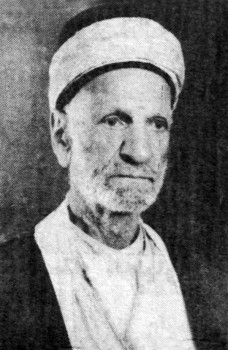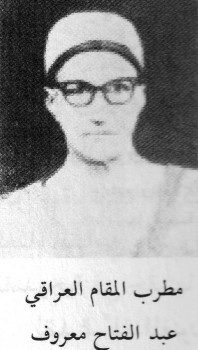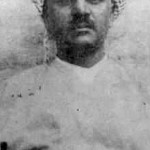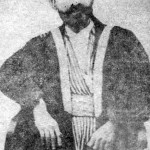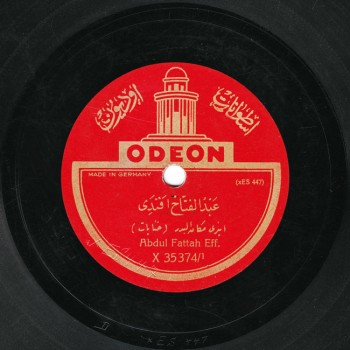 The Arab Music Archiving and Research foundation (AMAR), in collaboration with the Sharjah Art Foundation (SAF), presents “Min al-Tārīkh”.
The Arab Music Archiving and Research foundation (AMAR), in collaboration with the Sharjah Art Foundation (SAF), presents “Min al-Tārīkh”.
Dear listeners,
Welcome to a new episode of “Min al-Tārīkh”.
Today, we will be resuming our discussion about al-ṭarīqa al-Zaydāniyya.
Let us start with the muṭrib-s who followed Aḥmad al-Zaydān’s ṭarīqa.
I have talked about the disciples of the ṭarīqa Zaydāniyya, starting with (following the age) Ḥāj Jamīl al-Baghdādī (1876 – 1953) whose tendency towards religious rites showed in the way he dressed as he always wore the religious ‘amāma and jubbah (outer garment).
You mean that he did not wear the clothes of afandī-s?
All the photos we have show him wearing the ‘amāma and jubbah worn by religious ‘ālim-s.
Written and oral sources do not provide sufficient documented information on the great Iraqi maqām muṭrib, teacher, and expert Ḥāj Jamīl al-Baghdādī. Ḥāj Hāshim al-Rajab, who provided us with substantial information in general, said very little in his book “Al-maqām al-‘irāqī” about this capable muṭrib and influential maqām expert, even though they lived during the same period. I do not know why he wrote about the life of so many singers but did not write about Ḥāj Jamīl al-Baghdādī’s, and why he did not gather enough information on his life since he was so close to him.
Anyway… Ḥāj Hāshim al-Rajab says about al-Baghdādī: “Ḥāj Jamīl Bin al-Sayyid Salmān Bin Muṣṭafa Bin ‘Alī al-Baghdādī, born In Baghdad in 1294 Hijrī, studied Iraqi maqām and learned how to sing it from different singing sources, notably from famous maqām muṭrib Aḥmad al-Zaydān –so he is a disciple and pupil of al-ṭarīqa al-Zaydāniyya–, and from maqām muṭrib and expert Ṣāliḥ Abū Dumayrī. Al-Rajab assures that Ḥāj Jamīl al-Baghdādī is among the famous maqām singers who were masters of Iraqi maqām and the most knowledgeable as to its historical roots. He recorded a collection of Iraqi maqām-s with the foreign record companies that came to Baghdad in the 1920s in order to record its instru-vocal (instrumental and vocal / music and song) heritage. Ḥāj Jamīl al-Baghdādī started his career as a reciter of the Holy Quran and of religious rites including the manqaba nabawiyya sharīfa (the Virtues of the Prophet), Praise of the Prophet, dhikr, and tahlīl. He also worked, like his teacher, as a mumajjid in the “Murādiyya” mosque until he was finally appointed as an Iraqi maqām singing expert at the Iraqi Radio in Baghdad in 1951 after maqām expert Salmān Moshēh immigrated to occupied Palestine (the early 1950s witnessed the immigration of Jews to occupied Palestine –but this is not our subject– and thus many maqām singers left). He kept this position for approximately two years until he died on June 22nd 1953.
In his book “A‘lām al-maqām al-‘irāqī wa-ruwwāduh”, researcher Kamal Latif Salim wrote that Ḥāj Jamīl al-Baghdādī (1876 – 1953) was born in maḥallat or ḥārat “al-Bārūdiyya” in Baghdad, and learned to sing Iraqi maqām from a number of its reciters, notably Aḥmad al-Zaydān, Ṣāliḥ Abū Dumayrī, and Amīn al-Āghā. In 1926, he recorded with the foreign record companies a collection of Iraqi maqām including the: manṣūrī, ibrāhīmī, bayyāt, rāst, ṭāhir, mathnawī, mukhālaf, and ṣabā. He later worked as a mumajjid –as mentioned earlier– at the “Murādiyya” mosque. He distinguished himself by his authentic Baghdadi spirit, by his exacerbated senses, and by his musical taste, as well as by what he added to maqām, and to the respect he earned from his peers.
Now let us talk about another muṭrib, late ‘Abd al-Fattāḥ Ma‘rūf, who was first known as a Holy Quran reciter, and remained mostly known as such even though he recorded numerous non-religious Iraqi maqām, i.e. accompanied by music… Still, he had remained a Holy Quran and religious rites reciter for a very long time. The manqaba nabawiyya sharīfa (reciting the Virtues of the Prophet) flourished in Baghdad during the time period assimilated to the early 20th century, through Mullāh ‘Abd al-Fattāḥ Ma‘rūf and some of his extraordinary contemporaries. Relatively to the religious rites, note that ‘Abd al-Fattāḥ Ma‘rūf was a direct student of Mullāh ‘Uthmān al-Mawṣilī, while he learned non-religious Iraqi maqām singing from Aḥmad al-Zaydān, added to some of their great contemporaries including Ḥāfiẓ Khammās Qaddūr and Mullāh Mahdī al-Ḥāfiẓ who were all Mullāh ‘Uthmān al-Mawṣilī’s students.
The manqaba nabawiyya sharīfa –that had precise roots, awesome shape and content, and large audiences– started at the beginning of the evening and lasted until the dawn adhān of the next day. As mentioned in our previous episode, there are five faṣl, or six according to some, each of which is more than one hour’ long… they start at the ‘ashā’ and end at dawn. Each faṣl includes a fixed maqām sequence… and the manqaba nabawiyya sharīfa lasts until the dawn adhān. Each of the five one to one and a half hour’ long faṣl is followed by a pause that is in turn followed by a faṣl…etc. until dawn.
The imaginary and dreamy world of Mullāh ‘Abd al-Fattāḥ Ma‘rūf is like the world of the ancients who preceded him. He is considered as a classical artist who abided by the rules and believed in moral principles/values, in art and in life in general, yet with a new style in expressing resembling that of the realists. Mullāh ‘Abd al-Fattāḥ Ma‘rūf saw the nature of the different performance manners, whether their content was good or not. He was not the type of performer who relied on artistic opinions and points of view… as illustrated in his artistic production, including the Holy Quran reciting, the religious rites, or the mundane Iraqi maqām singing, that shows his uniqueness: Mullāh ‘Abd al-Fattāḥ Ma‘rūf did not insist on making a career out of his vocation as much as he insisted on the importance of practising one’s vocation and deepening one’s religious beliefs, and leading a natural and balanced life. His performances did not fully abide by the shape of the Iraqi maqām, such as those of ‘Abd al-Wahāb al-Bannā for example. Yet their shape is not bad either like, for example, the maqām-s performed by Muḥammad al-‘Āshiq where the shape and the content are in balance, like the performance of Mullāh ‘Abd al-Fattāḥ Ma‘rūf in general. ‘Abd al-Fattāḥ Ma‘rūf tried to establish a balance between the traditional uṣūl of maqām, i.e. preserving the shape and the expressive content of these maqām-s.
When was Ma‘rūf born and when did he die?
He lived 108 years.
God’s Grace!
He was born in 1881, and died in 1989, three months before al-Qubbāngī. I have relied on this date, based on the words of Ḥāj Hāshim al-Rajab: I once paid the latter a visit and he told me he had just come back from visiting ‘Abd al-Fattāḥ Ma‘rūf who was 104 years old. Four years later, ‘Abd al-Fattāḥ Ma‘rūf died… which means that he lived 108 years. So I dated back his birth to 1881.
You should have paid him a visit.
Unfortunately, I never met him. His sons are my friends though… some of them passed away… may they rest in peace. I would have liked to know him. I do not know why I never met him.
That is life…
‘Abd al-Fattāḥ Ma‘rūf sang a qaṣīda to the maqām mathnawī / ḥijāz that starts as follows:
Fuqta ḥusnan wa-su’dadan wa-iftikhārā zādaka al-Lāhu rif‘atan wa-wiqārā
He sang a cinquain qaṣīda to the manṣūrī / ṣabā:
Qul li-qawmī hum li-‘ishqī jahilū
Fī ḥabībī mā ilayhi waṣalū
Min gharāmī bayna qawmī fa-is’alū
Qad ḥala naẓmī wa-raqqa al-ghazalu
Min hawa qawmin bi-qalbī nazalū
Sheikh Salāma Ḥigāzī sang the same qaṣīda.
The same one? It was also interpreted by Ḥasan Khewka to the maqām dasht.
Strangely, all our recordings of ‘Abd al-Fattāḥ Ma‘rūf were made in the 1920s, even though he lived until 1989. He did not record after that… not even at the Radio.
‘Abd al-Fattāḥ Ma‘rūf wore a religious turban and had dedicated his life and his fame to his faith… He made these recordings and forgot about them…. Let us say that he did not perform maqām after the 1930s.
Did he record any Quran tilāwa?
He made many recordings. His youngest son Muḥammad, may he rest in peace, once paid me a visit carrying tapes of his father reciting the Quran, added to some tunes and songs. Furthermore, he once intrigued me with a recording of the song “Hēlā bēk”…
(♩)
This song, melody and lyrics, was interpreted by contemporary muṭrib Prof. Fāḍil ‘Awwād. Some think I composed it. I think that it was either composed by ‘Abd al-Fattāḥ Ma‘rūf, i.e. the performer himself, or that it was a religious piece by Mullāh ‘Uthmān al-Mawṣilī, their teacher.
You mean tanzīl.
Yes… many mundane songs today are originally religious.
Like qadd.
Exactly.
He sang “U‘āliju qalban fī hawākum mu‘adhdhabā wa-aṣbū ilaykum kulla-mā habba al-ṣabā” to the maqām ūrfa. This one too…
(♩)
Another muṭrib among the students and disciples of the ṭarīqa Zaydāniyya is Ḥāj ‘Abbās Kambīr al-Shaykhalī (1883 – 1965) –Note that some dates may not be precise.
Especially the birth dates.
Exactly, the documentation of the date of death is more precise, unlike birth dates.
Anyway, “Bāb al-Shaykh” (in reference to Sheikh ‘Abd al-Qādir al-Jīlanī) houses the shrine of Sheikh ‘Abd al-Qādir al-Jīlanī.
Is his takiyya still there?
Excuse me?
Is his takiyya still in Baghdad?
Yes, of course.
Originally from Afghanistan, Ḥāj ‘Abbās Kambīr al-Shaykhalī’s family settled in Baghdad long ago. His name is ‘Abbās Bin Muḥammad ‘Alī Bin ‘Abd al-Karīm, and his surname became al-Shaykhalī because his family settled in Bāb al-Shaykh… besides the fact that he was born in this region that is affiliated to Sheikh ‘Abd al-Qādir al-Jīlanī, may he rest in peace. ‘Abbās Kambīr practised religious performances at an early age. This period’s singers, specifically, all focused on religious performance as religious influence was much stronger in the 19th century than in the 20th that witnessed an evolution in technology and industry, and a change in standards in general.
Including the Sufi ṭarīqa-s.
Yes, of course.
The Sufi ṭarīqa-s played an important part in the religious musical practices.
Indeed.
Ḥāj Hāshim al-Rajab, in his book, wrote that ‘Abbās Kambīr al-Shaykhalī learned Iraqi maqām singing early in life under expert Khattāb Bin ‘Umar, then resumed his maqām studies under famous muṭrib Aḥmad al-Zaydān. Rajab added that muṭrib ‘Abbās Kambīr recorded ten discs in his voice that included the following ten Iraqi maqām: ḥusaynī, bayyāt, ṭāhir, nārī, maḥmūdī, sikāh, rāst, manṣūrī, khanabāt, and ḥijāz.
Let us listen to a sample.
All right. I would like to play for you something to the ḥusaynī whose taḥrīr is quite complex…
(♩)
Now a verse to the ḥusaynī …
(♩)
Dear listeners, we have reached the end of today’s episode of “Min al-Tārīkh”.
We thank Mr. Husayn al-A‘zami and all those who participated in enriching the collection of AMAR with their recordings.
Today’s episode included recordings from the collection of Prof. Ahmad al-Sabki. We also thank Mr. Ahmad al-Salihi and Sheikh Khalid Bin Hamad al-Thani.
We will meet again in a new episode of “Min al-Tārīkh” to resume our discussion about the disciples of al-ṭarīqa al-Zaydāniyya.
“Min al-Tārīkh” is brought to you by Mustafa Said.
- 221 – Zakariyya Ahmed – 12 (1/9/2022)
- 220 – Zakariyya Ahmed – 11 (1/9/2022)
- 219 – Zakariyya Ahmed – 10 (11/25/2021)
- 218 – Zakariyya Ahmed – 9 (10/26/2021)
- 217 – Zakariyya Ahmed – 8 (9/24/2021)
- 216 – Zakariyya Ahmed – 7 (9/4/2021)
- 215 – Zakariyya Ahmed – 6 (8/28/2021)
- 214 – Zakariyya Ahmed – 5 (8/6/2021)
- 213 – Zakariyya Ahmed – 4 (6/26/2021)
- 212 – Zakariyya Ahmed – 3 (5/27/2021)
- 211 – Zakariyya Ahmed – 2 (5/1/2021)
- 210 – Zakariyya Ahmed – 1 (4/28/2021)
- 209 – W-al-Lāhi lā astaṭī‘u ṣaddak 2 (4/6/2017)
- 208 – W-al-Lāhi lā astaṭī‘u ṣaddak 1 (3/30/2017)
- 207 – Bashraf qarah baṭāq 7 (3/23/2017)

